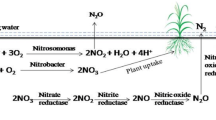Abstract
Continually rising concentration of greenhouse gases (GHGs) in the atmosphere is increasing concerns over how to manage global warming. Quantification of sources and sinks of these gases have been carried out, but there remains incoherence among the estimates due to different nature of sources and processes related therewith. This renders inter-comparison and further utilization of available assessments quite incomparable. Except major point sources like thermal power plants, cement manufacturing, etc. which have been quantified confidently (Matthews et al., 2008), fugitive and sensitive sources/sinks still need proper quantification. Agriculture is one such system which plays dominating role in the global fluxes of CH4 and N2O, as their biggest emitter. Substantial inputs of energy, machinery, synthetic fertilizers and pesticides in the modern agriculture bear embodied emissions in addition to much focused direct emissions from soil (Lal, 2004a). At the same time, agricultural soils may reportedly act as considerable carbon sink (Lal, 2004b). Therefore it becomes essential to integrate all inputs-outputs to estimate the actual impact.
Access this chapter
Tax calculation will be finalised at checkout
Purchases are for personal use only
Similar content being viewed by others
References
Bhatia, A., Pathak, H., Jain, N., Singh, P.K. Singh, A.K. (2005). Global warming potential of manure amended soils under rice–wheat system in the Indo-Gangetic plains. Atmos. Environ., 39: 6976-6984.
Burney, J.A., Davis, S.J. and Lobell, D.B. (2010). Greenhouse gas mitigation by agricultural intensification. Proc. Natl. Acad. Sci. USA, 107: 12052-12057.
Indian Network for Climate Change Assessment (INCCA), Ministry of Environment and Forests (MoEF) (2010). India: Greenhouse Gas Emissions 2007. Ministry of Environment and Forests. Government of India.
Intergovernmental Panel on Climate Change (IPCC) (2007). 2006 IPCC Guidelines for National Greenhouse Gas Inventories, Inst. for Global Environ. Strategies, Hayama, Japan.
Kramer, K.J., Moll, H.C. and Nonhebel, S. (1999). Total greenhouse gas emissions related to the Dutch crop production system. Agric. Ecosyst. Environ., 72: 9-16.
Lal, R. (2004a). Carbon emission from farm operations. Environ. Internat., 30: 981-990.
Lal, R. (2004b). Soil Carbon Sequestration Impacts on Global Climate Change and Food Security. Science, 304(11): 1623-1627.
Lal, R. (2008). Carbon sequestration. Phil. Trans. R. Soc. B., 363: 815-830.
Linquist, B., Van Groenigen, K.J., Adviento-Borbe, M.A., Pittelkow, C. and Van Kessel, C. (2011). An agronomic assessment of greenhouse gas emissions from major cereal crops. Global Change Biology, 18(1): 194-209.
Pandey, D., Agrawal, M. and Bohra, J.S. (2012). Greenhouse gas emissions from rice crop with different tillage permutations in rice–wheat system. Agric. Ecosyst. Environ., 159: 133-144.
Pandey, D., Agrawal, M. and Pandey, J.S. (2011). Carbon footprints: Current methods of estimation. Environ. Monit. Assess., 178: 135-160.
Pathak, H., Jain, N., Bhatia, A., Patel, J. and Aggarwal, P.K. (2010). Carbon footprints of Indian food items. Agric. Ecosyst. Environ., 139: 66-73.
Rovira, V. and Vallejo, V.R. (2002). Labile and recalcitrant pools of carbon and nitrogen in organic matter decomposing at different depths in soil: An acid hydrolysis approach. Geoderma, 107: 109-141.
Tirado, R., Gopikrishna, S.R., Krishnan, R. and Smith, P. (2010). Greenhouse gas emissions and mitigation potential from fertilizer manufacture and application in India. International J. Agric. Sustain., 8(3): 176-185.
West, T.O. and Marland, G. (2002). A synthesis of carbon sequestration, carbon emissions, and net carbon flux in agriculture: Comparing tillage practices in the United States. Agric. Ecosyst. Environ., 9: 217-232.
Matthews, S.C., Hendrickson, C.T. and Weber, C.L. (2008). The importance of carbon footprint estimation boundaries. Environ. Sci. Tech., 42: 5839-5842.
Acknowledgements
Divya Pandey is grateful to University Grants Commission, India for research fellowship. Authors thank Head, Department of Botany, Banaras Hindu University for providing necessary facilities. Director, Institute of Agriculture Sciences, Banaras Hindu University is acknowledged for granting permission for carrying out the field experiment at agriculture farm of the Institute. Authors also thank Dr. T. K. Adhya and Dr. Pratap Bhattacharya of Central Rice Research Institute, Cuttack, India for carbon analysis of soil. Financial assistance in the form of research project funded by University Grants Commission, New Delhi is gratefully acknowledged.
Author information
Authors and Affiliations
Corresponding author
Editor information
Editors and Affiliations
Rights and permissions
Copyright information
© 2015 Capital Publishing Company
About this chapter
Cite this chapter
Pandey, D., Agrawal, M., Bohra, J.S. (2015). Carbon Footprints of Rice Cultivation under Different Tillage Practices in Rice-wheat System. In: Raju, N., Gossel, W., Ramanathan, A., Sudhakar, M. (eds) Management of Water, Energy and Bio-resources in the Era of Climate Change: Emerging Issues and Challenges. Springer, Cham. https://doi.org/10.1007/978-3-319-05969-3_25
Download citation
DOI: https://doi.org/10.1007/978-3-319-05969-3_25
Published:
Publisher Name: Springer, Cham
Print ISBN: 978-3-319-05968-6
Online ISBN: 978-3-319-05969-3
eBook Packages: Earth and Environmental ScienceEarth and Environmental Science (R0)




